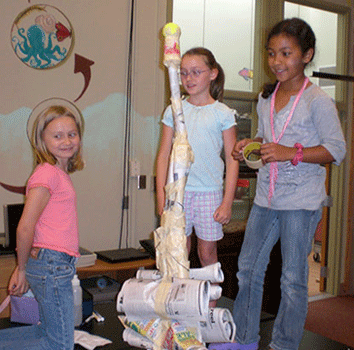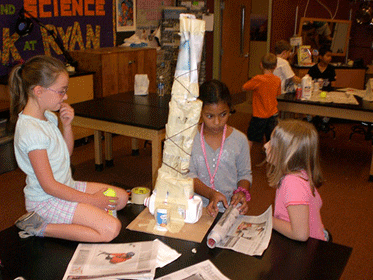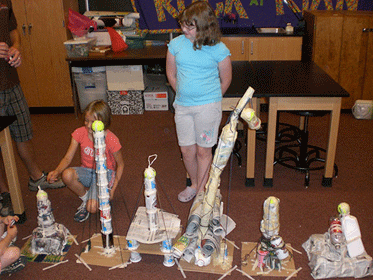Quick Look
Grade Level: 4 (3-5)
Time Required: 45 minutes
Expendable Cost/Group: US $0.50
Group Size: 3
Activity Dependency: None
Subject Areas: Earth and Space, Physical Science
NGSS Performance Expectations:

| 3-5-ETS1-1 |
| 3-5-ETS1-2 |
| 3-5-ETS1-3 |
Summary
Students learn about material reuse by designing and building the strongest and tallest towers they can using only recycled materials. Teams brainstorm, sketch the best design and create the towers to meet the design constraints. Then they test their towers in earthquake and high-wind simulations, followed by redesigning, rebuilding and retesting.
Engineering Connection
As the movement to reduce, reuse and recycle gains momentum, many engineers have become increasingly focused on incorporating reused and recycled materials into building designs. Civil, mechanical and environmental engineers work together to find ways to reuse materials in new homes and buildings without sacrificing function, comfort, beauty or reliability.
Learning Objectives
After this activity, students should be able to:
- Select a solution consistent with given constraints and explain why it was chosen.
- Describe the steps of the engineering design process.
- Collect information to evaluate the solution for a design problem.
Educational Standards
Each TeachEngineering lesson or activity is correlated to one or more K-12 science,
technology, engineering or math (STEM) educational standards.
All 100,000+ K-12 STEM standards covered in TeachEngineering are collected, maintained and packaged by the Achievement Standards Network (ASN),
a project of D2L (www.achievementstandards.org).
In the ASN, standards are hierarchically structured: first by source; e.g., by state; within source by type; e.g., science or mathematics;
within type by subtype, then by grade, etc.
Each TeachEngineering lesson or activity is correlated to one or more K-12 science, technology, engineering or math (STEM) educational standards.
All 100,000+ K-12 STEM standards covered in TeachEngineering are collected, maintained and packaged by the Achievement Standards Network (ASN), a project of D2L (www.achievementstandards.org).
In the ASN, standards are hierarchically structured: first by source; e.g., by state; within source by type; e.g., science or mathematics; within type by subtype, then by grade, etc.
NGSS: Next Generation Science Standards - Science
| NGSS Performance Expectation | ||
|---|---|---|
|
3-5-ETS1-1. Define a simple design problem reflecting a need or a want that includes specified criteria for success and constraints on materials, time, or cost. (Grades 3 - 5) Do you agree with this alignment? |
||
| Click to view other curriculum aligned to this Performance Expectation | ||
| This activity focuses on the following Three Dimensional Learning aspects of NGSS: | ||
| Science & Engineering Practices | Disciplinary Core Ideas | Crosscutting Concepts |
| Define a simple design problem that can be solved through the development of an object, tool, process, or system and includes several criteria for success and constraints on materials, time, or cost. Alignment agreement: | Possible solutions to a problem are limited by available materials and resources (constraints). The success of a designed solution is determined by considering the desired features of a solution (criteria). Different proposals for solutions can be compared on the basis of how well each one meets the specified criteria for success or how well each takes the constraints into account. Alignment agreement: | People's needs and wants change over time, as do their demands for new and improved technologies. Alignment agreement: |
| NGSS Performance Expectation | ||
|---|---|---|
|
3-5-ETS1-2. Generate and compare multiple possible solutions to a problem based on how well each is likely to meet the criteria and constraints of the problem. (Grades 3 - 5) Do you agree with this alignment? |
||
| Click to view other curriculum aligned to this Performance Expectation | ||
| This activity focuses on the following Three Dimensional Learning aspects of NGSS: | ||
| Science & Engineering Practices | Disciplinary Core Ideas | Crosscutting Concepts |
| Generate and compare multiple solutions to a problem based on how well they meet the criteria and constraints of the design problem. Alignment agreement: | Research on a problem should be carried out before beginning to design a solution. Testing a solution involves investigating how well it performs under a range of likely conditions. Alignment agreement: At whatever stage, communicating with peers about proposed solutions is an important part of the design process, and shared ideas can lead to improved designs.Alignment agreement: | Engineers improve existing technologies or develop new ones to increase their benefits, to decrease known risks, and to meet societal demands. Alignment agreement: |
| NGSS Performance Expectation | ||
|---|---|---|
|
3-5-ETS1-3. Plan and carry out fair tests in which variables are controlled and failure points are considered to identify aspects of a model or prototype that can be improved. (Grades 3 - 5) Do you agree with this alignment? |
||
| Click to view other curriculum aligned to this Performance Expectation | ||
| This activity focuses on the following Three Dimensional Learning aspects of NGSS: | ||
| Science & Engineering Practices | Disciplinary Core Ideas | Crosscutting Concepts |
| Plan and conduct an investigation collaboratively to produce data to serve as the basis for evidence, using fair tests in which variables are controlled and the number of trials considered. Alignment agreement: | Tests are often designed to identify failure points or difficulties, which suggest the elements of the design that need to be improved. Alignment agreement: Different solutions need to be tested in order to determine which of them best solves the problem, given the criteria and the constraints.Alignment agreement: | |
International Technology and Engineering Educators Association - Technology
-
Students will develop an understanding of the attributes of design.
(Grades
K -
12)
More Details
Do you agree with this alignment?
-
Students will develop an understanding of engineering design.
(Grades
K -
12)
More Details
Do you agree with this alignment?
-
Identify and collect information about everyday problems that can be solved by technology, and generate ideas and requirements for solving a problem.
(Grades
3 -
5)
More Details
Do you agree with this alignment?
-
Test and evaluate the solutions for the design problem.
(Grades
3 -
5)
More Details
Do you agree with this alignment?
-
Models are used to communicate and test design ideas and processes.
(Grades
3 -
5)
More Details
Do you agree with this alignment?
-
Apply the technology and engineering design process.
(Grades
3 -
5)
More Details
Do you agree with this alignment?
State Standards
New York - Science
-
Define a simple design problem reflecting a need or a want that includes specified criteria for success and constraints on materials, time, or cost.
(Grades
3 -
5)
More Details
Do you agree with this alignment?
-
Generate and compare multiple possible solutions to a problem based on how well each is likely to meet the criteria and constraints of the problem.
(Grades
3 -
5)
More Details
Do you agree with this alignment?
-
Plan and carry out fair tests in which variables are controlled and failure points are considered to identify aspects of a model or prototype that can be improved.
(Grades
3 -
5)
More Details
Do you agree with this alignment?
Materials List
Each group needs:
- 1 ft2 (0.1 m2) piece of cardboard
- 1 tennis ball
- 4 aluminum cans
- 12 sheets of newspaper
- 4 750-ml plastic bottles (such as soda bottles)
- 6 plastic yogurt cups
- 5 ft (1.5 m) string
- 5 ft (1.5 m) masking tape
- 1 pair of scissors
- 1 stopwatch
- Recycled Towers Worksheet, one per student
To share with the entire class:
- fan
- computer with projector to show the Recycled Towers Presentation
Worksheets and Attachments
Visit [www.teachengineering.org/activities/view/cub_environ_lesson05_activity3] to print or download.Introduction/Motivation
Do you ever wonder what happens to all the trash you throw away? Almost all of it ends up in landfills, which only have limited space. If we keep adding trash to landfills at our current rate, we will eventually fill up our landfills. Can you imagine what that would be like? With all the landfills full, what would we do with all our garbage? Surprisingly, a lot of the "trash" that ends up in landfills could actually be reused. Wouldn't it be great if people built homes from all the scrap pieces of metal, plastic, glass and other unwanted materials lying around? If we start using recycled garbage in buildings now, maybe we can reduce the amount of trash that ends up in landfills.
Some engineers have already started building homes and other buildings by reusing things other people would consider garbage. These engineers are continually working to find better ways to build homes and other buildings using recycled materials. Some new designs use old shipping containers for walls, collections of glass bottles for windows, and old pieces of tires as roofing material. Can anyone think of some other waste materials engineers could use in buildings? How could they be used? (For examples of homes with reusable materials, see: https://www.criticalcactus.com/beautiful-recycled-homes/, http://makewealthhistory.org/?s=mockbee, http://www.thedailygreen.com/green-homes/latest/shipping-container-homes-460309).
Today, we will get to reuse various materials, such as cans and newspaper, to design our very own towers! We want to prove that our towers are just as strong as buildings made from conventional or typical building materials, so we will also test our towers. Each building will undergo a wind test and an earthquake test. To add more of a challenge, you will have constraints just like real engineers. For example, your tower must be at least three feet tall and be able to hold a tennis ball on top. Sounds like a challenge we all can handle!

Procedure
Before the Activity

- Gather materials and make copies of the Recycled Towers Worksheet, one per student.
- Prepare to project the Recycled Towers Presentation to the class.
With the Students
- Show students the slide presentation to introduce them to the importance of recycling and reusing.
- Divide the class into groups of three students each.
- Explain the engineering design challenge: Students groups apply the recycling and reusing principles by building the tallest tower they can, using only recycled materials.
- Clarify the design constraints: minimum three-foot height, cardboard base, strong enough to support a tennis ball on top, ability to withstand wind and earthquake tests.
- Present the following activity overview and engineering design process information to the class:
- Now that you know about the constraints for this challenge, let's discuss the engineering design process.
- The time-tested steps of the engineering design process help engineers find good solutions to all sorts of problems.
- The first step is to identify the problem, which we have already done. Our problem is to figure out how to build a tower made from materials that would otherwise end up in the trash and add to landfills.
- The next step is to brainstorm for ideas. When you get into your groups, you will brainstorm ideas together. No idea is too crazy! Say anything that comes to mind and take notes to keep track of all ideas. Then, as a team, agree on one best idea from the brainstorming session as your design.
- When you draw plans for your design, make sure to label the materials.
- Once completed, show me (the teacher) your design. If I approve it, you can get your materials and move on to the building step!
- What do you think your group will do once you finish building? (Answer: Test.) You will test your structure to make sure it can withstand a wind test and an earthquake test.
- If it does not survive either test, what do you think you should do next? (Answer: Redesign, rebuild, retest.) You will redesign first, and then rebuild your tower according to the new design by reusing materials from your last design and/or incorporating additional materials. Once your new tower is complete, you can go back through the testing step. Just like engineers in the real world, you will repeat this as many times as necessary until you have a building that survives both tests. Let's begin!
- Hand out the worksheets.
- Give the teams time to brainstorm and design their towers.
- Permit one group at a time to collect its materials.
- Give students ~30 minutes to build their towers. You may want to point out that this time limit is an additional design constraint.
- After teams complete their towers, test each tower's ability to withstand the forces of nature. For the wind test, place the tower in front of a fan. Turn the fan on high for 30 seconds. Time how long the tower survives. Encourage students to make observations and record them on their worksheets. For the earthquake test, lightly shake the cardboard base of the tower for 30 seconds. Again, time how long the tower survives, and have students make and record observations on their worksheets.
- Have groups tear down their towers and sort the materials for recycling,
- Close with a class discussion in which groups share some results, reflections and conclusions about their final tower designs. What design strategies were used in the most successful towers?

Example completed recycled towers.
Vocabulary/Definitions
constraint: A requirement that must be satisfied for a design to be successful.
recycle: Treating or processing waste so that it can be reused.
reuse: Using materials again, often for something other than what they were made for in order to keep it from being thrown away. For example, using an old t-shirt as a rag.
Assessment
Pre-Activity Assessment
Class Discussion: As a class, discuss possible ways to reuse materials around the house. (Examples: Reusing plastic and glass containers for food storage, using plastic sandwich bags multiple times, using old t-shirts and sheets as cleaning rags, etc.) Also discuss how we, as a society, could reuse materials for buildings. To generate discussion, go over the recycled materials mentioned in the Recycled Towers Presentation, such as using plastic for lumber, recycled bottles for windows/light holes, etc.
Activity Embedded Assessment
Recycled Towers Worksheet: Have students use the Recycled Towers Worksheet to guide them through the activity. Review their drawings, data and answers to gauge their mastery of the subject matter.
Post-Activity Assessment
Commercial Break: Have groups come up with commercials or skits to perform in front of the class. The goal of the advertisement is to explain how the tower was built, why people might want to live in the tower, and why recycling and reusing is important for society.
Making Sense: Have students reflect about the science phenomena they explored and/or the science and engineering skills they used by completing the Making Sense Assessment.
Safety Issues
Remind students to be careful when using scissors. To avoid injuries, consider only having the teacher make cuts on harder materials, such as plastic bottles and yogurt cups.
Troubleshooting Tips
Remind students that they only get five feet of tape for the entire activity. Encourage them to conserve their supplies and only use a foot or two in their first designs. That way, if they need to redesign and rebuild, they have enough tape.
Activity Extensions
Have students each weigh their family's trash before it is taken to the dumpster. Keep track of how much trash each child's family produces over the course of two weeks. Challenge students to calculate how much trash was generated by all the families of the kids in the class during this time period. To incorporate more math, have students multiply this number out to reflect a year or 10 years. Explain that even more waste is being produced from manufacturing, businesses, restaurants, construction, mining, etc. Have students brainstorm how some of that waste can be reused or reduced, or never created in the first place!
Activity Scaling
- For lower grades, reduce the tower height requirement to two feet and do not require students to complete the second page of the Recycled Towers Worksheet.
- For upper grades, increase the weight at the top of each tower and provide a wider variety of materials.
Subscribe
Get the inside scoop on all things TeachEngineering such as new site features, curriculum updates, video releases, and more by signing up for our newsletter!More Curriculum Like This

Students expand their understanding of solid waste management to include the idea of 3RC: reduce, reuse, recycle and compost. They look at the effects of packaging decisions (reducing) and learn about engineering advancements in packaging materials and solid waste management.

In this lesson, students explore solid waste and its effects on the environment. They collect classroom trash for analysis and build model landfills in order to understand the process and impact of solid waste management.
Copyright
© 2012 by Regents of the University of ColoradoContributors
Jonathan McNeil; Malinda Schaefer Zarske; Jake Crosby; William Surles; Carleigh SamsonSupporting Program
Integrated Teaching and Learning Program, College of Engineering, University of Colorado BoulderAcknowledgements
The contents of this digital library curriculum were developed under grants from the Fund for the Improvement of Postsecondary Education (FIPSE), U.S. Department of Education and National Science Foundation (GK-12 grant no. 0338326). However, these contents do not necessarily represent the policies of the Department of Education or National Science Foundation, and you should not assume endorsement by the federal government.
Last modified: October 20, 2020








User Comments & Tips